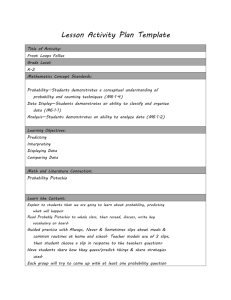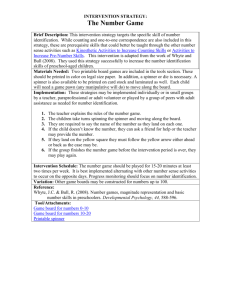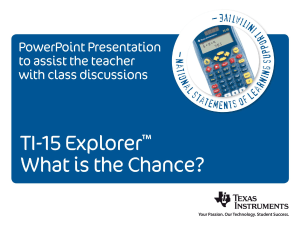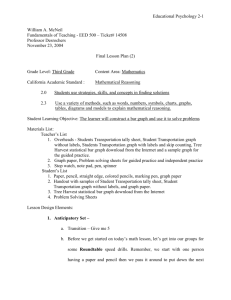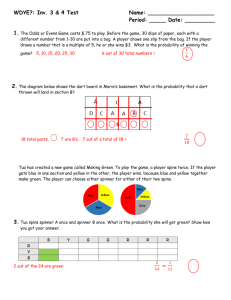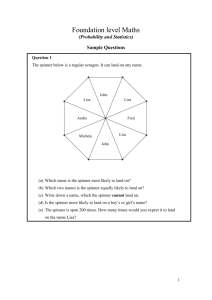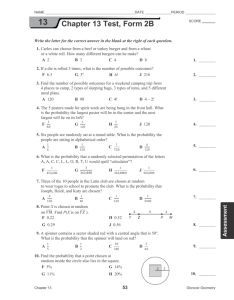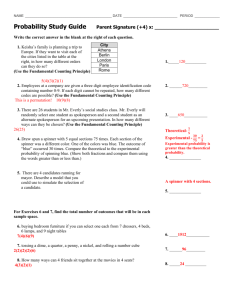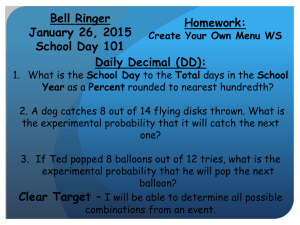ReisingerFinalProject - KStremmel
advertisement
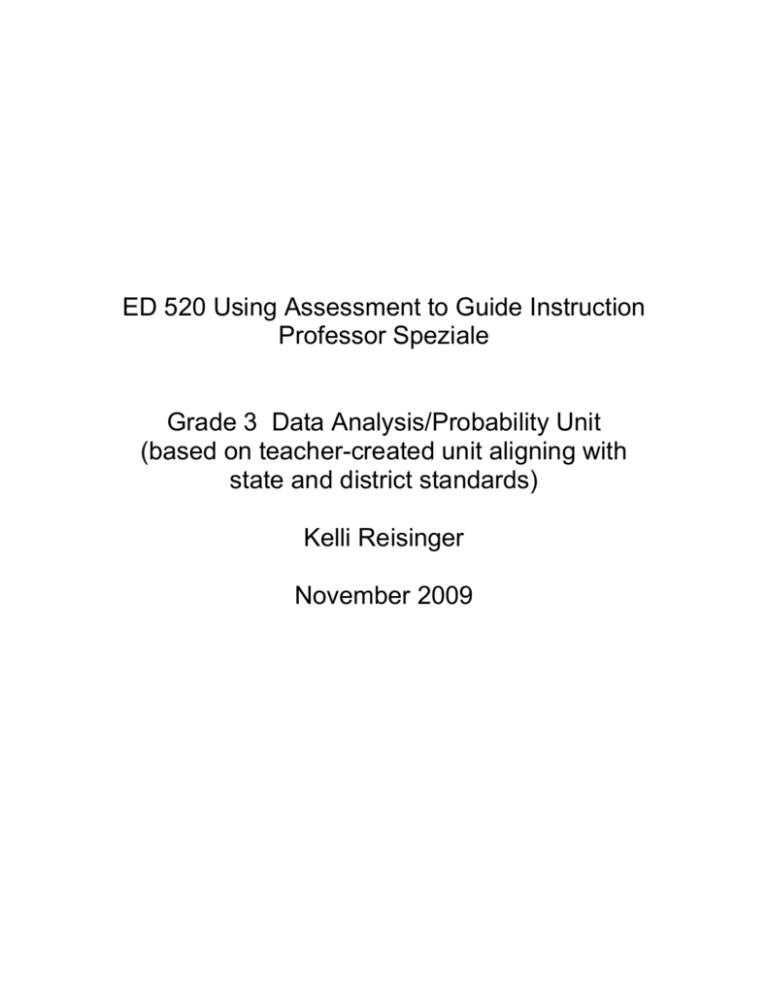
ED 520 Using Assessment to Guide Instruction Professor Speziale Grade 3 Data Analysis/Probability Unit (based on teacher-created unit aligning with state and district standards) Kelli Reisinger November 2009 This unit is designed for students to understand basic data analysis and probability concepts. It is created for third grade students and is to be taught in the spring. The students will be able to use probability terms, identify outcomes, differentiate between fair and unfair, and read and create graphs. Part 1 – Goals, Standards, Instructional Activities, and Learning Targets Goals and Academic Standards The goal of this unit is for students to be able to identify specific outcomes related to given situations. The students will be able to write outcomes in the form of general terms as well as fractions. Students will be able to determine the difference between fair and unfair spinners and state the reason why. The students will also be able to read and create pictographs and bar graphs using given information. These goals align with the state and district standards. Learning Targets Learning Target 1: The students will be able to correctly use the terms likely, unlikely, certain, and impossible by identifying the outcome of a given situation on student whiteboards. Students will also be able to correctly write each term in a sentence based on a student-created situation. Learning Target 2: The students will be able to analyze a spinner and recognize it as fair or unfair. The students will also be able to create their own fair and unfair spinners. Learning Target 3: The students will be able to write the probability as a fraction of pulling a certain color Froot Loop from a bag. Students will be able to keep a tally of how many times each color is pulled from a bag. Learning Target 4: The students will be able to name all parts of and read a pictograph. Learning Target 5: The students will be able to name all parts of and read a bar graph. Learning Target 6: The students will be able to work in small groups, choose a topic, find the outcomes, and create a bar graph and pictograph to represent the outcomes and a fair and unfair spinner to represent their topic on large paper to display and present to the class. Instructional Activities For Learning Target 1, the students will use student whiteboards to write the words likely, unlikely, certain, or impossible as a response to teachergiven statements. The teacher will informally assess student progress by noting students who are not choosing the correct term. The students will also write a sentence using each term correctly. They will choose one sentence and illustrate a picture. The teacher will check the sentences for understanding. For Learning Target 2, the students will analyze a given spinner. They will be able to name the spinner as fair or unfair and explain why. When given a blank spinner, students will create one fair spinner and one unfair spinner and be able to explain why it is fair or unfair. With a partner, students will test their spinners to see if they are correct. For Learning Target 3, students will be given a bag of Froot Loops. By tallying and recording the total number of Froot Loops in the bag and the total number of each color, the students will be able to write the probability of pulling each color. The students will then test their probabilities by blindly pulling Froot Loops from the bag and recording the color pulled by using a tally chart. The students will blindly pull 30 Froot Loops and put each Froot Loop back in the bag before pulling the next. For Learning Target 4, the students will be given a completed pictograph. After a teacher-guided lesson, the students will be able to name the parts of a pictograph – title, key, and labels. For Learning Target 5, the students will be given a completed bar graph. After a teacher-guided lesson, the students will be able to name the parts of a bar graph – title, labels, and scale. For Learning Target 6, in groups of 3, the students will choose an object that can be used with probability. They will find the total number of that object, the total number of each different part of the object, and find the probability of each different part being pulled. The students will show the number of each different object in the form of a pictograph and bar graph. The students will also show the probability of each different object being pulled from the bag. The students will then create a fair and unfair spinner to represent the information. The students will complete this project on large butcher paper. When completed, the students will present their results to the class. Part 2 – Assessment Plan Learning Target 1 will be assessed informally. To begin, the teacher will read statements that can have an outcome of likely, unlikely, certain, or impossible. An example of a statement is “It will rain today.” If rain is in the forecast, then the students would write the word “likely” on their whiteboard. If it is sunny outside, the students will write “unlikely” on their whiteboard. If it is raining at the time, students will write “certain” on their whiteboard. In this situation, there would be not possible reason to answer “impossible.” The teacher will informally assess the students’ answers by keeping track of those students who are continuing to answer incorrectly. During independent practice that day, the teacher will pull those students in a small group to have more practice. The second part of Learning Target 1 will be a constructed response assessment. The students are responsible for writing a statement using each of the four vocabulary terms. When the students are finished, they will switch papers with a partner to check the content. If there is a mistake, the partners will fix the statement together to make it true. These two assessments will both take place on day one. On the second day of the unit, Learning Target 2 will be introduced. After a guided lesson on fair and unfair spinners, the students will be creating their own fair and unfair spinners. The students will be responsible for dividing their spinner into equal or unequal parts and coloring each part to create a fair or unfair spinner. In this assessment, the students will self-assess. Each student will be given a paper clip. By holding the paper clip on the center of the circle using their pencil, the students will spin the spinner ten times and record each outcome. The students will then analyze their outcomes to see if they have created a fair or unfair spinner. On day three of the unit, Learning Target 3 will be completed. In this learning target, the students are learning how to create a table using tally marks and will be assessed as a performance assessment. The students will each be given a bag of a varied number of Froot Loops. The students will first count the total number of Froot Loops in the bag and record their score. The students will then add to their table the total number of each color of Froot Loops in their bag. Using this information, the students will be able to write the probability of choosing each color of Froot Loop. This performance assessment will be graded using a rating scale of 1 to 5. One meaning the table contained incorrect information and the tallying was not correct, and five meaning the table was correct as were all of the tallies. On the fourth day of the unit, Learning Target 4 will be assessed. In Learning Target 4, the students are responsible for being able to read and label all parts of a pictograph. To begin, the students will practice by naming and describing the parts – title, key, and label. They will then practice using the key to figure out how many of each different kind there are. Together with the teacher, the students will create a class pictograph for practice. The students will then be creating a pictograph for their own Froot Loop counts. They will create a part for each color of Froot Loop found in their bag. The students will find a scale and picture to use for their key and draw the picture for the appropriate number of each color. Their pictograph must have a title, labels, key, and accurate information for full credit. The students will be graded using a rubric. On day 5 of the unit, Learning Target 5 will be assessed. Learning Target 5 is very similar to Learning Target 4 except that the students will be reading and creating a bar graph instead of a pictograph. Again, the students will begin by analyzing a bar graph and creating one together as a class. The students will then use their data from Learning Target 3 create a bar graph representing their information. The students must decide on an appropriate scale for their numbers, create labels, a title, and correctly draw the bars. The students will again be graded using a rubric. On the final two days of the unit, the students will be completing Learning Target 6. In groups of 3 they will be using what they have learned to create a bar graph, pictograph, and spinner. The students will be assessed by themselves, their group members, and the teacher in this learning target. The students will fill out a reflection sheet based on how they feel they worked in a group, and will fill out a reflection sheet on each of their group members. These reflections will be factored into their final rubric score. In order to receive full credit from the teacher, the group members will need all three parts of the assessment. With the bar graph, the students must correctly represent their topic with an appropriate scale, title, labels, and correct use of the bars. For the pictograph, the students must choose an appropriate key and picture, have the correct number of pictures for each topic, labels, and a title. The students will also write the probability of each part of their topic being pulled from a bag. The students must create on fair spinner and one unfair spinner. If all parts of each section are correctly completed and the group members gave positive feed back, the students will receive full credit. The final project will be graded using a rubric. The second part of Learning Target 6 is for the students to present their information to the class. The students will be graded on volume, eye contact, and content using a rubric. As a final wrap-up of the unit on the eighth day, the students will take a cumulative assessment on all concepts learned. The assessment will consist of constructed response, selected response, and performance based questions and answers. Part 3 - Assessments Learning Target 1 Assessment Name ___________________________________ Date ________________ Directions: Use each of the following words in a sentence. Each sentence must have six or more words, appropriate capital letters, and ending punctuation. Impossible - ______________________________________________________ ________________________________________________________________ Unlikely - ________________________________________________________ ________________________________________________________________ Likely - __________________________________________________________ ________________________________________________________________ Certain - ________________________________________________________ ________________________________________________________________ Directions: Choose one sentence and draw a picture of it in the box below. Learning Target 2 Assessment Name ___________________________________ Date ________________ Directions: Using the blank circles, create one fair and one unfair spinner. Write the word fair or unfair under your spinner. Write one to two sentences explaining why the spinner is fair or unfair. _______________ ________________________________________________________________ ________________________________________________________________. _______________ ________________________________________________________________ ________________________________________________________________. Learning Target 3 Assessment Name ___________________________________ Date ________________ Write the total number of Froot Loops in your bag. _______________ Froot Loops in my bag Tally the number of each color of Froot Loops in your bag. Tally chart of Froot Loop Colors Color of Froot Loop Number of Froot Loops Purple Blue Orange Yellow Red Green Write the probability of pulling each color of Froot Loops from your bag. Purple ____/____ Blue ____/____ Orange ____/____ Yellow ____/____ Red ____/____ Green ____/____ Learning Target 4 Assessment Name ___________________________________ Date ________________ Directions: Using your tally chart from Day 3, create a pictograph representing the number of Froot Loops of each color in your bag. Remember to have all parts of a pictograph: title, key, and labels. ________________ = ________________ Learning Target 5 Assessment Name ___________________________________ Date ________________ Directions: Using your tally chart from Day 3, create a bar graph representing the number of Froot Loops of each color in your bag. Remember to have all parts of a pictograph: title, labels, scale, and accurate bars. Learning Target 6 Assessment Name ___________________________________ Date ________________ Directions: Using a piece of pre-cut butcher paper, and information from your group’s topic, create a bar graph, pictograph, and one fair and one unfair spinner. Be sure to include the probability of choosing each object in your topic from a bag. Self Reflection Rate yourself with a 3 (you always did this), 2 (you did this sometimes), or 1 (you did not do this). Name __________________________ I worked well with my group members. 3 2 1 I added my input to my group’s ideas. 3 2 1 I helped record data. 3 2 1 Group Member Reflection Rate each of your group members with a 3 (they always did this), 2 (they sometimes did this), or 1 (they did not do this). Name _________________________ Group Member’s Name ____________________________ He/she worked well with all group members. 3 2 1 He/she added input to our group’s ideas. 3 2 1 He/she helped record data. 3 2 1 Name ___________________________ Date _____________________ Probability Unit Test Use the information below to answer questions 1. James went to the park with his dog. When he was there, he saw: 4 Poodles 6 Labradors 5 Golden Retrievers 3 Bull Dogs 1. Using your information, complete the blank pictograph below. Remember to label all parts of the pictograph. Title: Key: Choose the best answer for questions 2 and 3. 2. Which of these statements describes an unlikely event? a. It will snow in Orlando, Florida. b. There are seven days in this week. c. You will have math class everyday this week. d. You will grow to be 50 feet tall. 3. If you have 6 marbles in a bag: 1 black, 2 red, 2 green, and 1 blue, what is the probability that you will choose a green marble? a. 5/6 b. 1/6 c. 3/6 d. 2/6 Use the bar graph below to answer questions 4 and 5. Number of Marbles Earned in One Day for Four Students 6 5 4 3 Number of Marbles 2 1 0 Johnny Sammy Molly Annie Students 4. How many more marbles does Molly need to have the same amount as Johnny? a. 4 b. 1 c. 3 d. 2 5. How many more marbles does Annie have than Sammie? a. 4 b. 1 c. 3 d. 2 Use the information below to choose the best answer for questions 6 - 9. (4 parts blue, 3 parts red, 1 part green) 6. It is likely that the spinner will land on the color ________. a. red b. blue c. green 7. True (T) or False (O): This is a fair spinner. ______________ 8. Which color is the spinner least likely to land on? a. red b. blue c. green 9. What is the probability that the spinner will land on blue? a. 3/8 b. 2/8 c. 5/8 d. 4/8 Compare the two bar graphs to answer questions 10 - 12. Number of Students in 3rd Grade who got an A on the Math Test in November 9 8 7 6 5 4 3 2 1 0 3-D Column 1 Class 1 Class 2 Class 3 Class 4 3rd Grade Classrooms Number of Students in 3rd Grade who got an A on the Math Test in March 9 8 7 6 5 4 3 2 1 0 3-D Column 1 Class 1 Class 2 Class 3 Class 4 3rd Grade Classrooms 10. In which classroom did the students do better on the math test in March than November? a. Classroom 1 b. Classroom 2 c. Classroom 3 d. Classroom 4 11.Which classroom had 6 students who got an A on the math test in March? a. Classroom 1 b. Classroom 2 c. Classroom 3 d. Classroom 4 12. After totaling each classroom’s amount of students who got an A for November and March, which classroom had the most amount of students with an A? a. Classroom 1 b. Classroom 2 c. Classroom 3 d. Classroom 4 ANSWER KEYS Learning Target 1 Assessment: Answers will vary, but here are some possibilities. Pictures will vary as well. Impossible – It is impossible that a real dinosaur will appear in your backyard. Unlikely - It is unlikely that it will snow in November. Likely – It is likely that we will go on vacation this summer. Certain – It is certain that you go to third grade at Hayshire Elementary School. Learning Target 2 Assessment For a fair spinner, all parts are equal and the odds of spinning each color/number are equal. For an unfair spinner, the parts may not be equal and/or the odds of spinning each color/number may not be equal. Learning Target 3 Assessment Answers will vary. Students need to correctly tally the number of each color of Froot Loops in their bag. They must then use those numbers to write the correct probability of pulling each color from the bag. Total number of Froot Loops: 31 Blue – 5 Probability – 5/31 Red – 7 Probability – 7/31 Orange – 8 Probability – 8/31 Green – 3 Probability – 3/31 Yellow – 2 Probability – 2/31 Purple – 6 Probability – 6/31 Rating Scale: 5 (all information correct) 4 information) 3 2 1(incorrect/lacking Learning Target 4 Assessment Answers will vary. Students must select an appropriate object to use for their key. They will decide how many Froot Loops that object will be worth. They will draw the appropriate number of that object for each color of Froot Loops. Category Title 4 Rubric for Pictograph 3 Title is creative and clearly relates to the problem being graphed. Units are described with accurate key. Units Graph is completed neatly and clearly. Neatness/ Attractiveness 2 1 Title clearly relates to the problem being graphed. A title is present at the top of the graph. A title is not present. One unit is described with an accurate key . Graph is completed clearly. Units are described with a key. Units are not described with a key. Graph is completed somewhat clear, but not neat. Graph is not clear or neat. Learning Target 5 Assessment Again, answers will vary. Students must select an appropriate scale and label for the y-axis. They must also write the colors on the x-axis with an appropriate label. Bars must not be touching, a consistent width, and the correct height matching their tally chart. Category Title Units Labeling X Axis Labeling Y Axis 4 Rubric for Bar Graph 3 2 Title is creative and clearly relates to the problem being graphed. Both units are described with accurate labels. The X axis has a clear, neat label that describes the units. The Y axis has a clear, neat label that describes the units. 1 Title clearly relates to the problem being graphed. A title is present at the top of the graph. A title is not present. One unit is described with accurate labels. The X axis has a clear label that describes the units. The Y axis has a clear label that describes the units. Units are described with labels. The X axis has a label. Units are not described with labels. The X axis is not labeled. The Y axis has a label. The Y axis is not labeled. Learning Target 6 Assessment Answers will vary. Students must select an appropriate topic to find the probability of, such as candy, toy cars, other cereal, etc. They must find the total number of that topic, the total number of each kind, find the probability of pulling each kind, create a bar graph and a pictograph representing the information, and create a fair and unfair spinner using their selected topic. Students will self and peer assess using the reflection sheets. The students will be teacher-assessed by a rubric when they are presenting their information to the rest of the class. Rubric for assessing Oral Presentation of Learning Target 6 Category 4 3 2 1 Speaks clearly and Speaks clearly and Speaks clearly and Often mumbles or Speaking Posture and Eye Contact Volume Content distinctly all (10095%) the time, and mispronounces no words. distinctly all (10095%) the time, but mispronounces one word. distinctly most ( 9485%) of the time. Mispronounces no more than one word. cannot be understood OR mispronounces more than one word. Stands up straight, looks relaxed and confident. Establishes eye contact with everyone in the room during the presentation. Volume is loud enough to be heard by all audience members throughout the presentation. Stands up straight and establishes eye contact with everyone in the room during the presentation. Sometimes stands up straight and establishes eye contact. Slouches and/or does not look at people during the presentation. Volume is loud enough to be heard by all audience members at least 90% of the time. Volume is loud enough to be heard by all audience members at least 80% of the time. Volume often too soft to be heard by all audience members. Shows a full understanding of the topic. Shows a good understanding of the topic. Shows a good understanding of parts of the topic. Does not seem to understand the topic very well. Unit Assessment 1. Answers will vary. Key must be appropriate for graph and accurate for each type of dog. 2. a 3. d 4. c 5. d 6. b 7. O 8. c 9. d 10. a 11. c 12. b
